Editing
24 Sep 201824 minutes to read
Editing Modes
The TreeGrid provides support to add, edit and delete the records and the following are the types of editing modes available.
- Cell Editing
- Row Editing
- Dialog Editing
- Batch Editing
You can enable editing in TreeGrid by enabling the property allowEditing.
Cell Editing
Update the record through editing a cell by setting editMode as the cellEditing.
The following code example shows you how to enable the cellEditing in TreeGrid control.
$("#TreeGridContainer").ejTreeGrid({
//...
editSettings: {
allowEditing: true,
editMode: "cellEditing"
},
});The output of the TreeGrid with cellEditing is as follows.
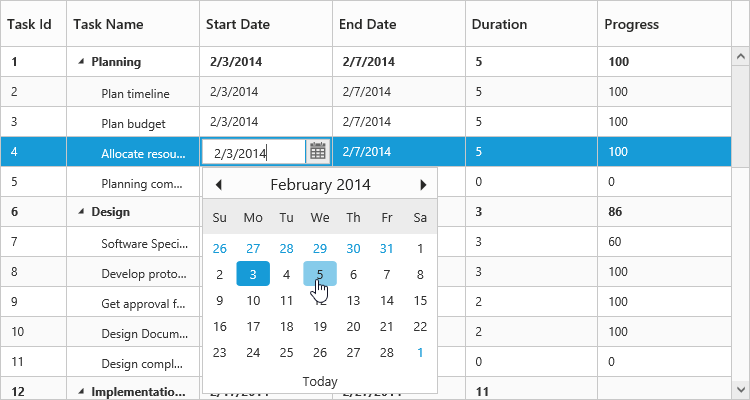
The edited cell can be saved with custom actions using the saveCell method.
Prevent cell editing
In cell edit action beginEdit and editEdit events are triggered before and after the editing action. cell editing for specific cell can prevent by using beginEdit event.
The following code example show, how to prevent cell editing in tree grid.
$("#TreeGridContainer").ejTreeGrid({
//...
editSettings: {
allowEditing: true,
editMode: "cellEditing"
},
beginEdit:function(args)
{
if(args.columnIndex == 1)
args.cancel = true;
},
//...
});Row Editing
It is possible to make the entire row to editable state and to update a record by setting editMode as rowEditing.
The following code example shows you how to enable rowEditing in TreeGrid control.
$("#TreeGridContainer").ejTreeGrid({
//...
editSettings: {
allowEditing: true,
editMode: "rowEditing"
},
});The following output is displayed as a result of the above code example.
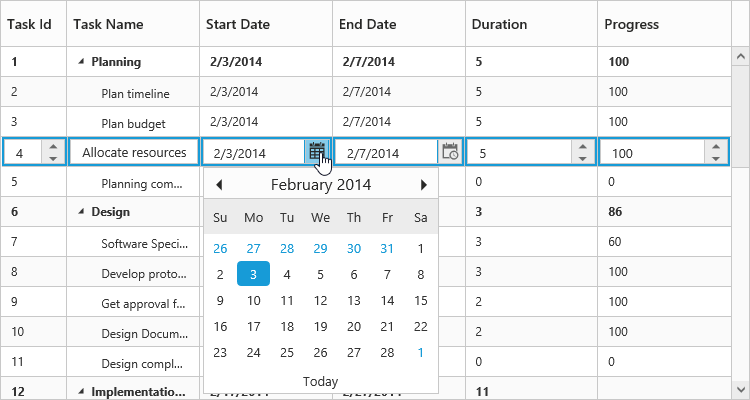
Dialog Editing
Set the editMode as dialogEditing to edit/add a record using dialog.
The following code example shows you how to enable the dialogEditing in TreeGrid control.
$("#TreeGridContainer").ejTreeGrid({
//...
editSettings: {
allowEditing: true,
editMode: "dialogEditing"
},
});The output of the TreeGrid with dialogEditing is as follows.
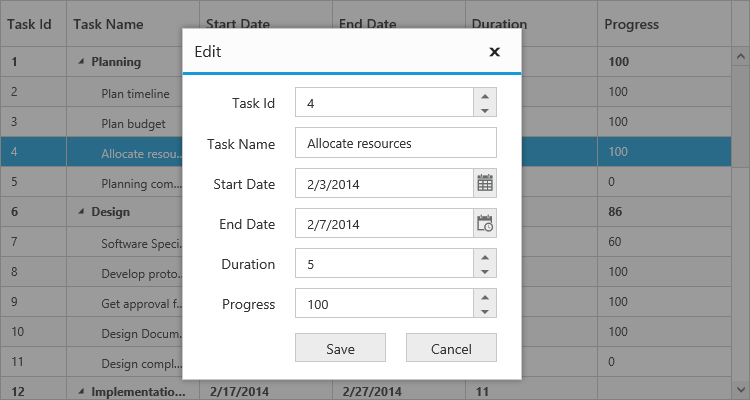
The add and edit dialogs can be opened on custom actions instead of toolbar icons using the methods showAddDialog and showEditDialog.
Prevent dialog editing
In dialog editing action actionBegin and actionComplete client side events are triggered before and after the edit action. Dialog editing for specific row can be prevent by using actionBegin event.
The following code example show, how to prevent dialog editing in tree grid.
$("#TreeGridContainer").ejTreeGrid({
//...
editSettings: {
allowEditing: true,
editMode: "dialogEditing"
},
actionBegin:function(args)
{
if(args.requestType == "beforeOpenEditDialog")
{
if(args.data.taskID == 4)
args.cancel = true;
}
},
//...
});NOTE
While saving the edited record
actionCompleteevent will be triggered with updated record value indataargument andrequestTypeasrecordUpdate. Using this event we can update the information in database.
Batch Editing
The batch editing support in the tree grid is used to save all added, edited, and deleted changes to the database with a single action. This can be enabled by setting the editMode property to batchEditing. The following code example shows how to enable the batchEditing in the tree grid control.
$("#TreeGridContainer").ejTreeGrid({
//...
editSettings: {
allowEditing: true,
beginEditAction: "click",
editMode: "batchEditing"
},
});The output of a tree grid with batchEditing is as follows.
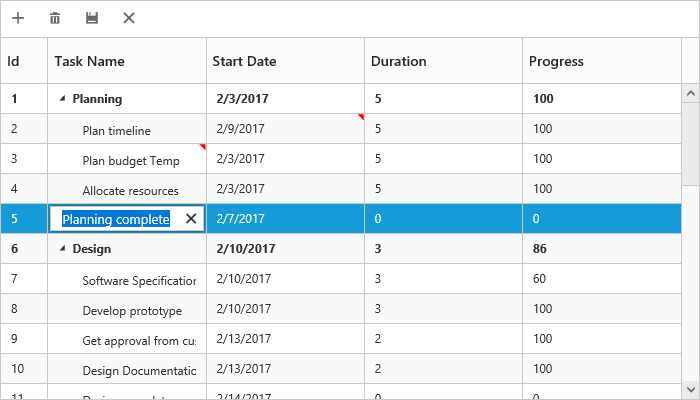
In batch editing, the edit mode can be changed to cell or row or dialog with the batchEditSettings.editMode property. The following code snippet shows how to set the editMode to row in the batchEditSettings property.
$("#TreeGridContainer").ejTreeGrid({
//...
editSettings: {
allowEditing: true,
beginEditAction: "click",
editMode: "batchEditing",
batchEditSettings: { editMode: "row" },
},
});The output of a tree grid with batchEditSettings and editMode set as row is as follows.
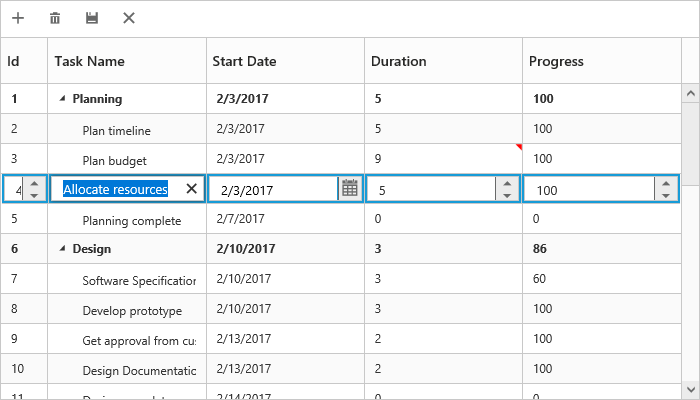
NOTE
After modifying all changes in the tree grid, click the save button in the toolbar. The
actionCompleteevent will be triggered with updated records in thebatchChangesargument withrequestTypeargument asbatchSave. Using this event, you can update all the modified records to the database.
Cell edit type and its params
The edit type of columns can be customized using editType property of columns. The following Essential JavaScript controls are supported built-in by editType. You can set the editType based on specific data type of the column.
-
CheckBoxcontrol for boolean data type. -
NumericTextBoxcontrol for integers, double, and decimal data types. -
InputTextBoxcontrol for string data type. -
DatePickercontrol for date data type. -
DateTimePickercontrol for date-time data type. -
DropDownListcontrol for list of data type.
And also you can define the model for all the editTypes controls while editing through editParams property of columns.
The following code example describes the above behavior.
$("#TreeGridContainer").ejTreeGrid({
//...
columns: [
{ field: "taskID", headerText: "Task Id", editType: "numericedit" },
{ field: "taskName", headerText: "Task Name", editType: "stringedit" },
{ field: "startDate", headerText: "Start Date", editType: "datepicker"},
{ field: "endDate", headerText: "End Date", editType: "datepicker"},
{ field: "duration", headerText: "Duration", editType: "numericedit", editParams: {decimalPlaces:2} },
],
//...
});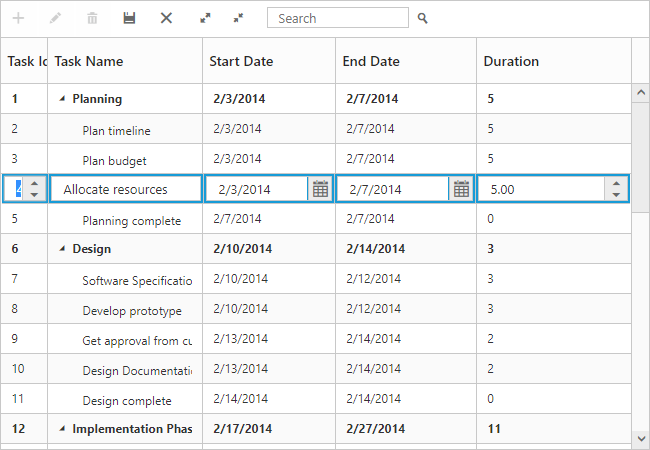
The above screenshot shows TreeGrid with different edit type.
Assign data source for drop down edit type
In TreeGrid, we need to assign the data source for drop down list control to populate the suggestion list while editing the column in tree grid. The dropdownData property is used to set the drop down list data source in TreeGrid control.
The following code example shows how to set data source for drop down edit type.
var data = [
{id:1, text: "Low", value: "Low" },
{id:2, text: "Normal", value: "Normal" },
{id:3, text: "High", value: "High" },
{id:4, text: "Critical", value: "Critical" }
];
$("#TreeGridContainer").ejTreeGrid({
//...
columns: [
//..
{ field: "priority", headerText: "Priority", editType: "dropdownedit", dropdownData: data },
],
//...
});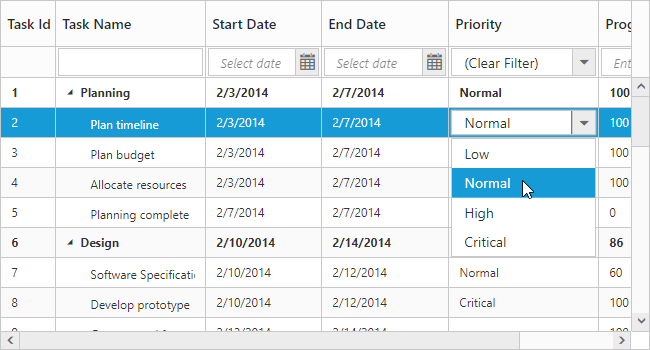
The above screenshot shows drop down edit type in tree grid.
Dialog Template
You can edit any of the fields pertaining to a single record of data and apply it to a template so that the same format is applied to all the other records that you may edit later.
Using this template support, you can edit/add the fields that are not bound to TreeGrid columns.
To edit/add the records using dialog template form, set editMode as dialogEditing and specify the template id to dialogEditorTemplateID property of editSettings.
NOTE
The
valueattribute is used to bind the corresponding field value while editing.
Thenameattribute is used to get the changed field values while saving the edited record.
Theidattribute must to be set in the format of ( treegrid control id + fieldname).
The following code example describes the above behavior.
<script type="text/x-jsrender" id="template">
<div>
<b>Task Details</b>
<table cellspacing="10" class="beta">
<tr>
<td style="text-align:right;padding: 10px;">
TaskID
</td>
<td style="text-align: left;padding: 10px;">
<input id="TreeGridContainertaskID" type="number" name="taskID" value="{{:taskID}}" disabled="disabled" class="e-field e-ejinputtext valid e-disable"/>
</td>
<td style="text-align: right;padding: 10px;">
TaskName
</td>
<td style="text-align: left;padding: 10px;">
<input id="TreeGridContainertaskName" name="taskName" value="{{:taskName}}" class="e-field e-ejinputtext valid"/>
</td>
</tr>
<tr>
<td style="text-align: right;padding: 10px;">
StartDate
</td>
<td style="text-align: left;padding: 10px;">
<input type="text" id="TreeGridContainerstartDate" name="startDate" value="{{:startDate}}" class="e-field e-ejinputtext valid" />
</td>
<td style="text-align: right;padding: 10px;">
EndDate
</td>
<td style="text-align: left;padding: 10px;">
<input id="TreeGridContainerendDate" type="text" name="endDate" value="{{:endDate}}" class="e-field e-ejinputtext valid" />
</td>
</tr>
</table>
</div>
</script>$("#TreeGridContainer").ejTreeGrid({
//...
editSettings: {
allowEditing: true,
editMode: "dialogEditing",
dialogEditorTemplateID: "#template"
},
});The following output is displayed as a result of the above code example.
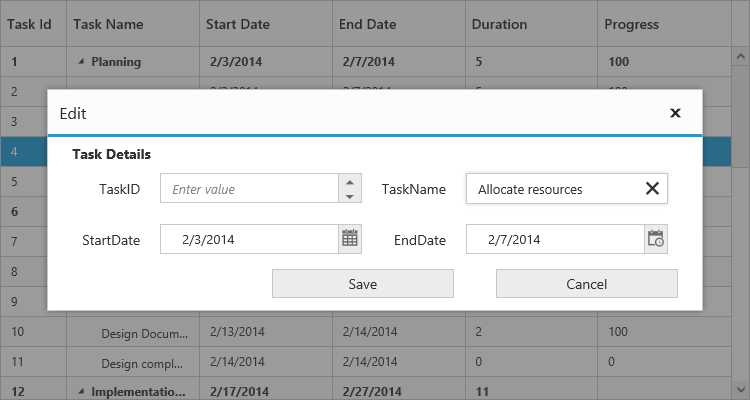
Using methods to open dialog
It is possible to open the add dialog dynamically with a custom using the method showAddDialog..
Similarly, open the Edit dialog dynamically using the method showEditDialog(index), with the index of the row to be edited as parameter.
<script>
$("#add").click(function (args) {
treegridObj = $("# TreeGridContainer ").data("ejTreeGrid");
treegridObj.showAddDialog();
})
$("#edit").click(function (args) {
treegridObj = $("# TreeGridContainer ").data("ejTreeGrid ");
treegridObj.showEditDialog(3);
})
</script>Edit cell/row by single click
The TreeGrid control provide the support for single click edit action for cell and row edit by setting beginEditAction property as click, default value this property is dblClick.
The following code example shows how to enable single click edit in tree grid.
$("#TreeGrid").ejTreeGrid({
//...
editSettings: {
beginEditAction:ej.TreeGrid.BeginEditAction.Click,
},
//...
});Cell Edit Template
Edit template is used to create custom editor for editing the column values. It can be created by using the editTemplate property of columns.
The following are the functions available for edit template.
-
create- It is used to create the control at time of initialize. -
read- It is used to read the input value at time of save. -
write- It is used to assign the value to control at time of editing.
The following code example describes edit template behavior.
<script>
var autocompleteData = ["Planning", "Plan Timeline", "Plan Budget", "Allocate Resources", "Planning Complete"];
$("#treegrid").ejTreeGrid({
//...
editSettings: {
allowAdding: true,
allowEditing: true,
allowDeleting: true
},
columns: [{
field: "taskName",
headerText: "Task Name",
editTemplate: {
create: create,
write: write,
read: read,
}
}],
//...
});
function create() {
return "<input>";
}
function write(args) {
args.element.ejAutocomplete({
width: "100%",
dataSource: autocompleteData,
enableDistinct: true,
value: args.rowData !== undefined ? args.rowData["taskName"] : ""
});
}
function read(args) {
args.ejAutocomplete('suggestionList').css('display', 'none');
return args.ejAutocomplete("getValue");
}
</script>The output of the TreeGrid width editTemplate as follows.
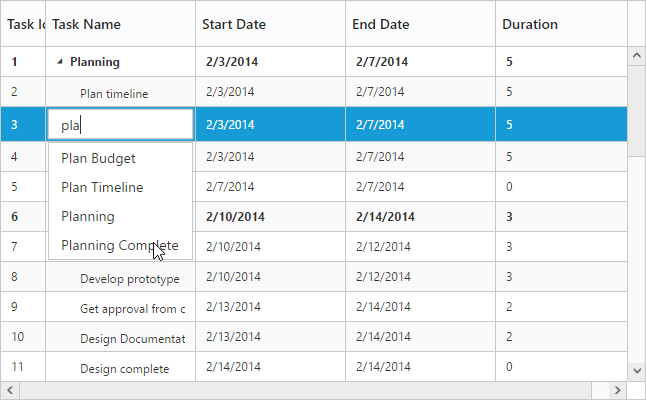
The updated record values are maintained in collection in TreeGrid, and the user can retrieve the updated record collection at any time by using the getUpdatedRecords method.
Add new record
TreeGrid provides support for adding a new record by setting allowAdding property as true. You can add new record by toolbar add item click or context menu.
The below code example shows how to enable add new record option in TreeGrid.
$("#TreeGrid").ejTreeGrid({
//...
editSettings: {
allowAdding: true,
},
//...
});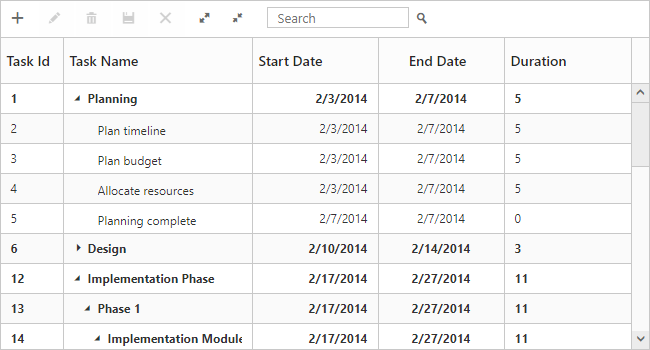
The above screenshot shows before add a new record in tree grid.

The above screenshot shows after add a new record in tree grid.
Add row position
The TreeGrid control provides the support to add the new row in the top, bottom, above selected row, below selected row and child position of tree grid content using rowPosition property.
The below code example shows how to set row position for new record add in tree grid.
$("#TreeGrid").ejTreeGrid({
//...
editSettings: {
allowAdding: true,
rowPosition:ej.TreeGrid.RowPosition.Child,
},
//...
});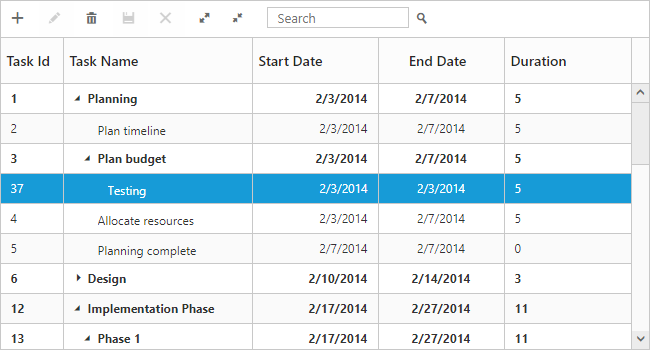
The above screenshot shows new record added in row position of child.
Adding records using method
Records can be added dynamically to TreeGrid using the method addRow. Before calling this method, you should enable the allowAdding property.
The below code snippet explains dynamically inserting a record in tree grid. The record will be inserted as a child node to the current selected record.
var treeGridObj = $("#treegrid").data("ejTreeGrid");
var data = {
taskId: "40",
taskName: "New Task 40",
startDate: "2/20/2014",
startDate: "2/25/2014"
};
treeGridObj.addRow(data, ej.TreeGrid.RowPosition.Child); // To add a taskUsing the row position parameter of the method, user can able to insert the record at any desired index at run-time. The user can insert a record dynamically in the following positions
- Top: Top to all the existing records
- Bottom: Bottom to all the existing records
- Above: Above to the selected row
- Below: Below to the selected row
- Child: As a child to the selected row
The row position can be also defined while initializing the TreeGrid. The below code example shows how to set row position for adding new record in TreeGrid.
$("#TreeGrid").ejTreeGrid({
//...
editSettings: {
allowAdding: true,
rowPosition: ej.TreeGrid.RowPosition.Child,
},
//...
});
The above screenshot shows new record added in row position of child.
updating records using method
Records can be updated dynamically to TreeGrid using the method updateRecordByIndex. Record index and the data to be updated will be passed to the method argument to update.
The below code snippet explains dynamically updating a record in tree grid.
var treeGridObj = $("#treegrid").data("ejTreeGrid");
var data = {
taskName: "Updated task",
};
treeGridObj.updateRecordByIndex(2,data); // To update a taskDelete record
TreeGrid provides support to delete a record by enabling allowDeleting property.
The below code example shows how to enable delete option in TreeGrid.
$("#TreeGrid").ejTreeGrid({
//...
editSettings: {
allowDeleting: true,
},
//...
});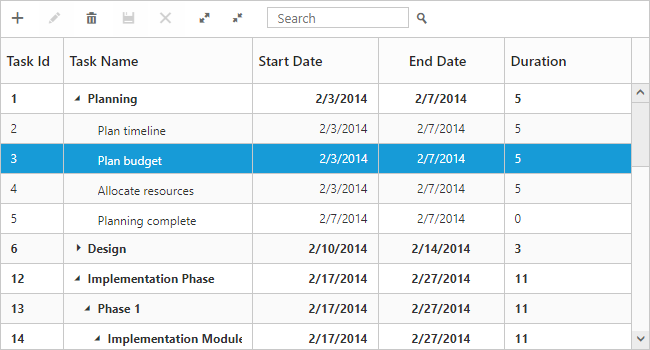
The above screenshot shows before delete a record in tree grid.
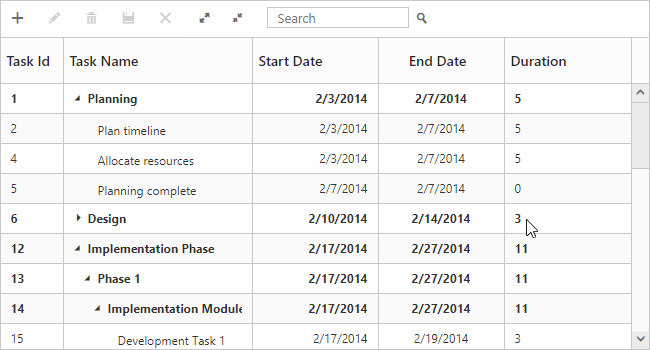
The above screenshot shows after delete a record in tree grid.
Delete confirmation message
Delete confirmation message is used to get the confirmation from the user before delete the record. This confirmation message can be enabled by setting showDeleteConfirmDialog property as true.
The following code snippet explains how to enable delete confirmation message in tree grid.
$("#TreeGrid").ejTreeGrid({
//...
editSettings: {
allowDeleting: true,
showDeleteConfirmDialog: true
},
//...
});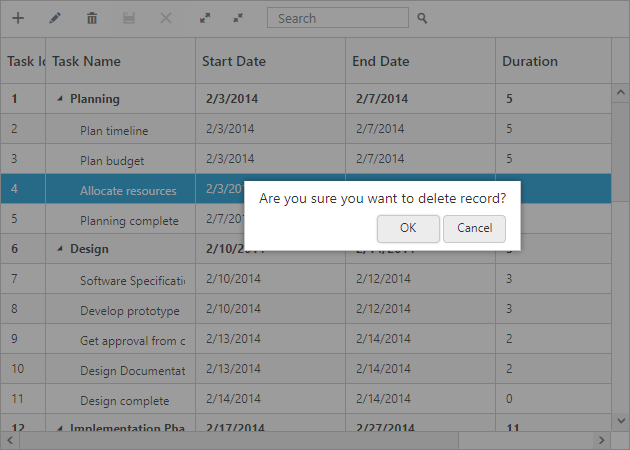
The above screen shot shows the appearance of delete confirmation message in treegrid.